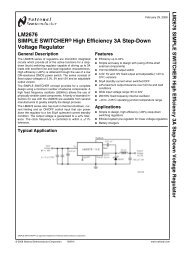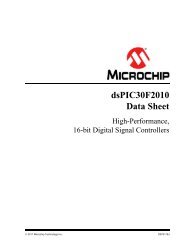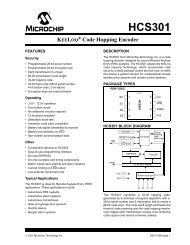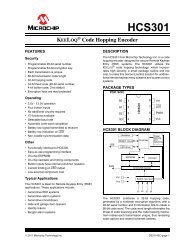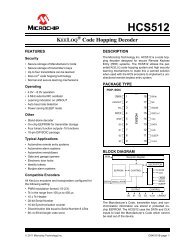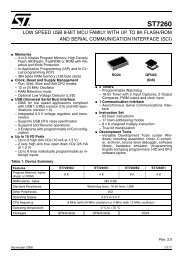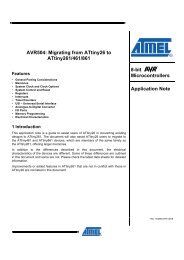You also want an ePaper? Increase the reach of your titles
YUMPU automatically turns print PDFs into web optimized ePapers that Google loves.
System modules<br />
<strong>STM32W108C8</strong><br />
calibrated accuracy of OSCHF is ±250 kHz ±40 ppm. The UART and ADC peripherals may<br />
not be usable due to the lower accuracy of the OSCHF frequency.<br />
See also Section 14.5.1: High frequency internal clock characteristics on page 199.<br />
6.3.2 High-frequency crystal oscillator (OSC24M)<br />
The high-frequency crystal oscillator (OSC24M) requires an external 24 MHz crystal with an<br />
accuracy of ±40 ppm. Based upon the application's bill of materials and current<br />
consumption requirements, the external crystal may cover a range of ESR requirements.<br />
The crystal oscillator has a software-programmable bias circuit to minimize current<br />
consumption. ST software configures the bias circuit for minimum current consumption.<br />
All peripherals including the radio peripheral are fully functional using the OSC24M clock<br />
source. Application software must be aware that peripherals are clocked at different speeds<br />
depending on whether OSCHF or OSC24M is being used.<br />
If the 24 MHz crystal fails, a hardware failover mechanism forces the system to switch back<br />
to the high-frequency RC oscillator as the main clock source, and a non-maskable interrupt<br />
(NMI) is signaled to the ARM® Cortex-M3 NVIC.<br />
See also Section 14.5.2: High frequency external clock characteristics on page 199.<br />
6.3.3 Low-frequency internal RC oscillator (OSCRC)<br />
A low-frequency RC oscillator (OSCRC) is provided as an internal timing reference. The<br />
nominal frequency coming out of reset is 10 kHz, and ST software calibrates this clock to<br />
10 kHz. From the tuned 10 kHz oscillator (OSCRC) ST software calibrates a fractional-N<br />
divider to produce a 1 kHz reference clock, CLK1K.<br />
See also Section 14.5.3: Low frequency internal clock characteristics on page 199.<br />
6.3.4 Low-frequency crystal oscillator (OSC32K)<br />
A low-frequency 32.768 kHz crystal oscillator (OSC32K) is provided as an optional timing<br />
reference for on-chip timers. This oscillator is designed for use with an external watch<br />
crystal.<br />
See also Section 14.5.4: Low frequency external clock characteristics on page 200.<br />
6.3.5 Clock switching<br />
The <strong>STM32W108C8</strong> has two switching mechanisms for the main system clock, providing<br />
four clock modes.<br />
The register bit OSC24M_SEL in the OSC24M_CTRL register switches between the highfrequency<br />
RC oscillator (OSCHF) and the high-frequency crystal oscillator (OSC24M) as<br />
the main system clock (SCLK). The peripheral clock (PCLK) is always half the frequency of<br />
SCLK.<br />
The register bit CPU_CLK_SEL in the CPU_CLKSEL register switches between PCLK and<br />
SCLK to produce the ARM® Cortex-M3 CPU clock (FCLK). The default and preferred mode<br />
of operation is to run the CPU at the lower PCLK frequency, 12 MHz, but the higher SCLK<br />
frequency, 24 MHz, can be selected to give higher processing performance at the expense<br />
of an increase in power consumption.<br />
39/215 Doc ID 018587 Rev 2





